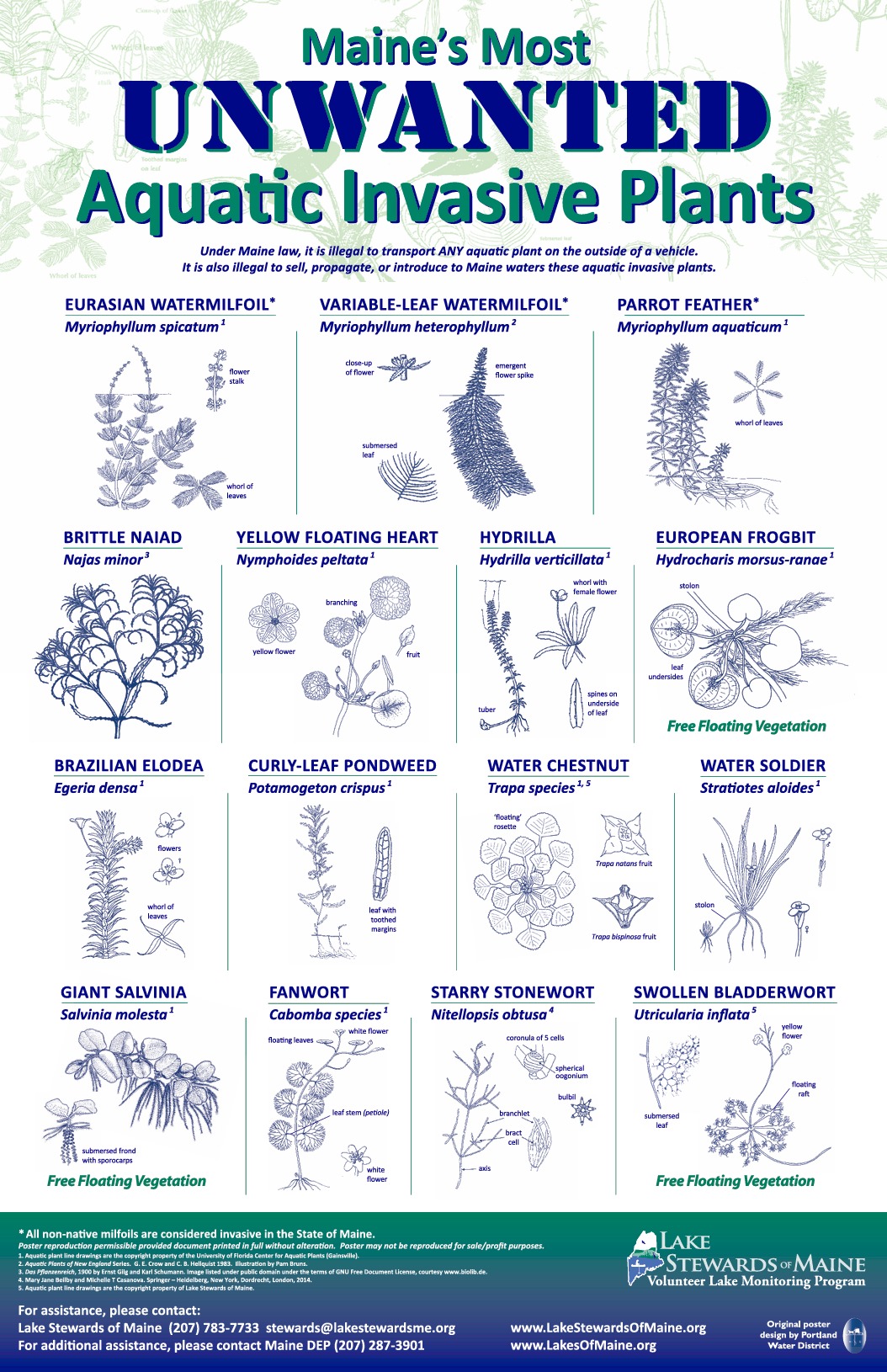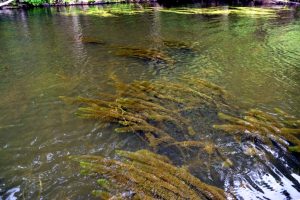Lake Stewards of Maine has released the latest “Maine’s Most Unwanted Aquatic Invasive Plants” poster. The previous version pictured 11 plants. This new one has pictured 15 plants. You can right click the image to view and download a full sized image, or click the image to view and download the file as a PDF. You’ll also find it in our Maps Charts & Graphs gallery.
Category Archives: aquatic plants
17 August 2021: Milfoil Returns to Cobbossee Lake
Eurasian Water-Milfoil was discovered in Cobbossee Lake in 2018 (see our post dated August 8, 2018: “Invasive Milfoil Confirmed in Cobbosseecontee Lake“). The following year Maine’s Department of Environmental Protection treated several areas of the lake with an herbicide in an attempt to kill off the invasive plant. They were optimistic that the treatment would be successful because the infestation was limited (so they thought) to roughly an acre between the north shore and Island Park. Sadly, the following year Milfoil was again discovered in several areas adjacent to the original infestation, which is where this Central Maine Papers newspaper article picks up. Please read it! It paints an ugly but accurate picture of the situation they’re facing trying to eradicate this unwanted aquatic plant: Continue reading
5 August 2020: CBI Mid-Summer Update

Jack Holland conducting courtesy boat inspections at the State boat launch. Photo by George Fergusson
Our Courtesy Boat Inspection program is running like a well oiled bicycle this summer, thanks to an energetic and committed volunteer work force. We got a bit of a late start last year, but this year we started boat inspections on Memorial Day weekend and have managed to have volunteers at the State boat launch every weekend from 6 AM until 2 PM ever since. To date we’ve staffed 93 two-hour shifts for a total of 192.1 volunteer hours and have conducted 315 inspections. So far this year we’ve only found one plant on an inbound boat that turned out not to be invasive. State-wide there have been 4,312 shifts (most are two hour shifts but some are longer) and 54,815 inspections conducted and 1,616 plants were found, 67 of which have been identified as invasive plants. I’d say the program is working! You can look at the data directly using the 2020 Maine Courtesy Boat Inspection Dashboard. Select the Clary Lake Association from the “Select Organization” list to see our data. Continue reading
2019 Courtesy Boat Inspection Wrap Up.
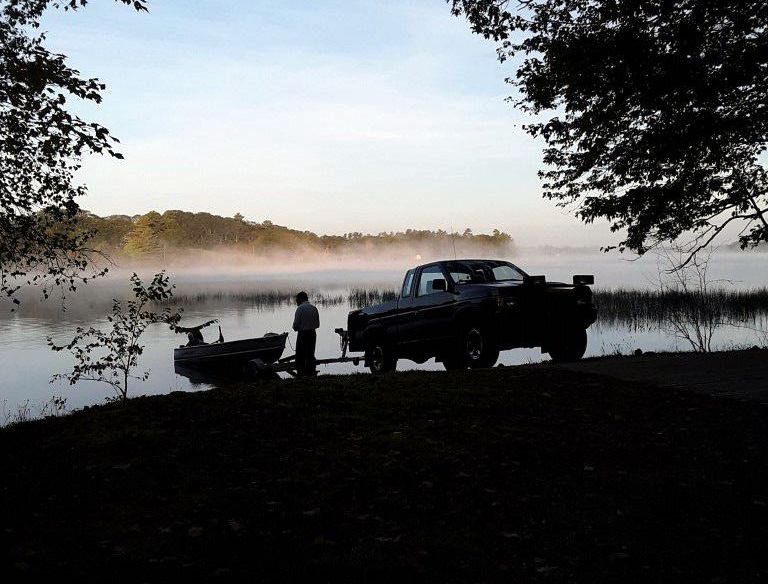 Last weekend marked the conclusion of the Clary Lake Association’s first Courtesy Boat Inspection season and I’d like to thank our volunteers who gave of their valuable time to help out at the boat launch this past summer. In no particular order: Dave & Gayle Knight, Dan & Dolly Burns, Gareth Bowen, Wynne & Michael Keller, Malcolm Burson, Jack Holland, and George & Margaret Fergusson.
Last weekend marked the conclusion of the Clary Lake Association’s first Courtesy Boat Inspection season and I’d like to thank our volunteers who gave of their valuable time to help out at the boat launch this past summer. In no particular order: Dave & Gayle Knight, Dan & Dolly Burns, Gareth Bowen, Wynne & Michael Keller, Malcolm Burson, Jack Holland, and George & Margaret Fergusson.
The purpose of the State’s Courtesy Boat Inspection Program is to prevent the transport and introduction of invasive aquatic plants into lakes in Maine, and this is the 19th year that the program has been in existence. With the repaired dam and newly restored water level this Spring we anticipated a significant increase in boat traffic and our concerns understandably turned to protecting Clary Lake from the chance introduction of invasive aquatic plants. It took a little while to get up and running, but finally, in early July, about a dozen CLA volunteers attended a short training session put on by Midcoast Conservancy (see “Courtesy Boat Inspection Training Set For July 1st“) and we started up our inspection program the following Saturday. Our goal was to have a courtesy boat inspector at the State boat launch on Saturdays and Sundays from 7 am until 3 pm. We broke the days up into 2 hour shifts. Continue reading
Courtesy Boat Inspection Training Set For July 1st
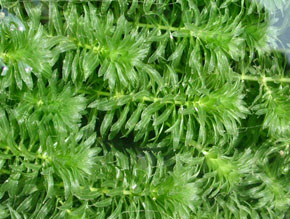
HYDRILLA (Hydrilla verticillata)
What do courtesy boat inspectors do? The program is really an educational one. As boaters launch and remove their boats from the water, CBIs will discuss with boaters how invasive aquatic plants spread, show how to inspect boats and equipment for plant fragments, urge boaters to inspect before and after every launch, distribute information about invasive plants, and articulate Maine law regarding the transport of these plants.
We need volunteers! Our goal is to line up enough Courtesy Boat Inspectors to be able to cover the State boat launch on Clary Lake during the “busy” hours (7 AM to 3 PM) on weekends, as those are the days that typically see the most boat traffic. Typically volunteers would sign up for 2 hour shifts, and inspections would continue through Labor Day. If you’re interested in helping out with this important initiative, please contact the Secretary.
24 May 2019: CLA To Conduct Courtesy Boat Inspections

HYDRILLA (Hydrilla verticillata)
With the State boat launch back in service, our concerns rightly turn to protecting Clary Lake from the chance introduction of invasive aquatic plant species. To that end, the Clary Lake Association is gearing up to start participating in Maine’s Courtesy Boat Inspection (CBI) program starting this summer, and we’re going to need volunteers! While there are various ways invasive plants can make it into lakes, by far the most common transport mechanism is on boats and trailers. Sadly, there are a number of lakes in the State with an invasive aquatic plant problem including several nearby lakes. The goal will be to have enough people lined up and trained so that the boat launch can be covered during the weekends to inspect boats and trailers before they they put in the lake, to make sure there are no invasive plants hitching a ride. Continue reading
Invasive Milfoil Confirmed in Cobbosseecontee Lake
We really need an invasive plant patrol program here on Clary Lake.
 Breaking News From
Breaking News From
Maine Department of Environmental Protection
Invasive Milfoil Confirmed in Cobbosseecontee Lake
Rapid response aims to keep plants in check
AUGUSTA, August 7, 2018
– Maine Department of Environmental Protection (DEP) has confirmed growth of Eurasian water milfoil (Myriophyllum spicatum) in the north end of Cobbosseecontee (aka Cobbossee) Lake in Winthrop. The plant was discovered in July by Friends of Cobbossee Watershed (FOCW) plant surveyors. DEP, FOCW and Cobbossee Watershed District have searched for and removed plants since last month’s discovery. Continue reading
29 July 2018: Have You Seen This Plant? [UPDATED]
Purple Loosestrife (Lythrum salicaria) is a common invasive plant in Maine. The plant propagates by seed and invades many types of wetlands where it crowds out native plants and degrades wetland habitat. We certainly don’t want it getting a foothold around Clary Lake! A little over a week ago while out fishing, I spotted 2 purple loosestrife plants growing on the south shore of Clary Lake. Yesterday afternoon, CLA President Malcolm Burson and trudged across the marsh and dug them up and hauled them off which is the approved method of control for this plant. If you just cut them down, they will regrow from the roots though I know from experience that if you keep cutting them down a few years running, eventually the plant will die. I actually cut this particular plant down last summer and it regrew this year from the root stock. Digging them up is the sure-fire way to rid yourself of this invasive plant. There are a few more pictures in the Spring/Summer 2018 photo gallery. Continue reading
18 July 2016: Alarming Growth of Elodea Observed in Clary Lake
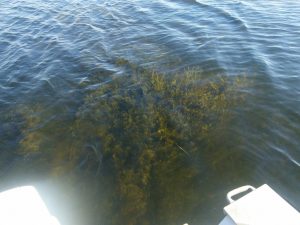
Elodea nuttallii in Clary Lake growing to the surface in 7′ of water. Photograph by George Fergusson 15 July 2016
Just when you thought conditions around Clary Lake couldn’t get any worse, well conditions got worse: anyone who has spent any time on Clary Lake this summer is all too aware of the explosive growth of Elodea in shallow areas around the lake. Rapid growth of this pond weed was a noticeable problem last summer and it has only gotten worse, not better. Elodea nuttallii is not a recognized invasive plant species in Maine but it is considered invasive in some jurisdictions including in Europe where it is a real problem. It’s an opportunistic plan in any case, and under the right conditions it can be very prolific. Clearly the conditions existing in Clary Lake now are about perfect to promote exuberant growth of this plant: lots of shallow water with a muddy bottom, plenty of nutrients, and lots of sun. Elodea growth has gotten so bad in some places that there are large mats of the weed on or just under the surface of the water, even near the middle of the lake. I took the above picture about 1400′ off the south shore of the lake- almost 1/3 of the way across to the other side- in 7′ of water. Normally the water would be 12 feet deep here, too deep to support the growth of Elodea. Now, with the lake level down 5 feet below the top of the dam, conditions are perfect. Everywhere you go it seems you’re seeing Elodea at or just below the surface. You’ll find more pictures in the Spring/Summer 2016 photo gallery. Continue reading
07 September 2015: Is Metaphyton growth in Clary Lake a cause for concern?
If you’ve spent any time on Clary Lake this summer you’ve seen those green “cotton candy” clouds of algae floating around near the shore. These blooms of algae are most commonly found in shallow (littoral) areas of lakes and are comprised of free-floating masses of filamentous green algae (primarily Spirogyra, Gonium, and Zygnema) and is referred to collectively as Metaphyton. Because they’re unattached (free-floating) they tend to move around with wind and water currents so one day you might not see any on your shore line and the next the bottom could be covered with it. Metaphyton masses will often get entangled with sticks, rocks, mooring lines, and other pond plants and then they don’t move around but remain in one place. Scientists are still learning about what influences the growth of metahphyton and its significance and potential impact on water quality besides the obvious “yuck” factor. Metaphyton can form dense mats that trap gasses given off by plant decomposition, causing them float to the surface where wind and waves cause them to break up and dissipate. Continue reading
28 July 2015: Duncan road lake shore owners severely impacted by low water
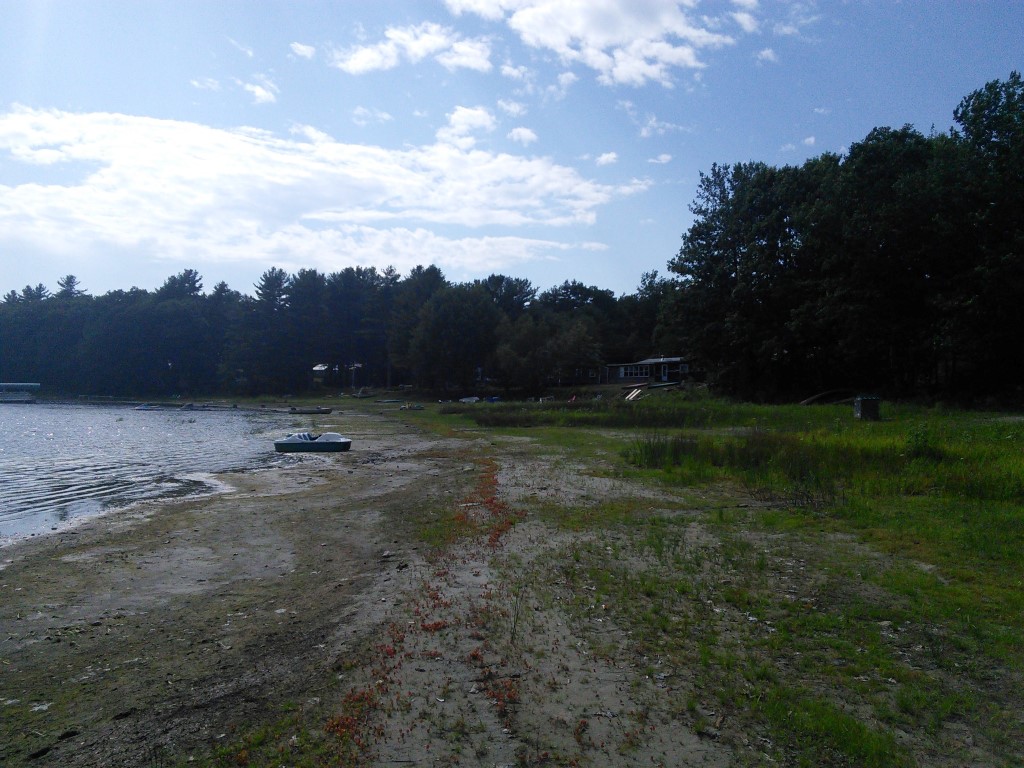
Duncan Road, north shore. The water level in this picture was 63″ below the top of the dam. Photograph by George Fergusson 28 July 2015
Everyone around the lake has been impacted by the Clary Lake water level crisis to some extent, some more than others depending on the nature of their shoreline. However, it is hard to believe the conditions the people over by Duncan Road on the north shore of the lake have been putting up with going on 4 years now. I had been over that way in my boat a few times earlier this year, but I never got too close to shore because of shallow water. I knew that the lake had receded quite a bit, but I really was not prepared for what I found today when I went over to look around. I drove over, parked, and walked around for almost an hour, taking pictures. It was a beautiful day, high summer in Maine, and not a soul to be seen. Nobody was there. No kids. No dogs. Nobody. And no wonder: it’s not a place anyone wants to hang out any more. Continue reading
08 July 2015: Lake shore owners concerned about invasive aquatic plants [UPDATED]
 Last week I noticed some large and extensive mats of a green pond weed over by my shoreline in about 2′-3′ of water, thick enough to foul my trolling motor and bring my boat to a halt. I collected a sample and identified it as Elodea or American water weed (or Common Pond Weed). I was therefore not particularly surprised when Thomas Gillette showed up at my house yesterday with a shopping bag full of this plant, concerned that Clary Lake might have an invasive plant infestation underway. Thomas told me that Butch Duncan had brought it to him, saying that there were thick mats of it over in the cove on the north side of the lake by Duncan Road.
Last week I noticed some large and extensive mats of a green pond weed over by my shoreline in about 2′-3′ of water, thick enough to foul my trolling motor and bring my boat to a halt. I collected a sample and identified it as Elodea or American water weed (or Common Pond Weed). I was therefore not particularly surprised when Thomas Gillette showed up at my house yesterday with a shopping bag full of this plant, concerned that Clary Lake might have an invasive plant infestation underway. Thomas told me that Butch Duncan had brought it to him, saying that there were thick mats of it over in the cove on the north side of the lake by Duncan Road.
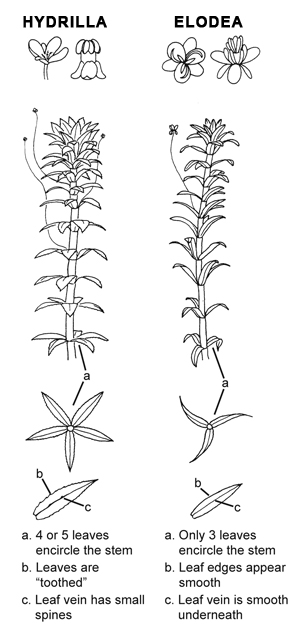 I reassured Thomas that this was not an invasive species. We’ve had this plant growing in Clary Lake forever but it’s always remained under control. You’d see a few pieces of it wash ashore from time to time or you might see patches of it up in the channel. Recently however, conditions around the lake have become quite conducive to this plant’s rapid growth in areas where it was not found before. Elodea is not a recognized invasive plant species but under the right conditions it can and does become a nuisance, clogging shallow water areas with thick mats of vegetation. Elodea likes nutrient-rich water down to several meters (5′-7′) in depth, plenty of sunlight, water temperatures between 10° C and 25° C and a soft, silty or muddy bottom where it’s thin wiry roots can get a good foot hold. You won’t find Elodea on a rocky or gravel bottom. With the water level down 5′ and 50% of the volume of the lake gone, conditions around Clary Lake are near perfect for this plant’s growth to explode: the reduced lake volume increases the concentration of nutrients in the water and the lowered lake level allows sunlight to reach down to silty/muddy areas that would normally be under 7′ to 10′ of water where Elodea wouldn’t normally be found, or be able to survive. Now our shallow water areas are a perfect habitat for Elodea.
I reassured Thomas that this was not an invasive species. We’ve had this plant growing in Clary Lake forever but it’s always remained under control. You’d see a few pieces of it wash ashore from time to time or you might see patches of it up in the channel. Recently however, conditions around the lake have become quite conducive to this plant’s rapid growth in areas where it was not found before. Elodea is not a recognized invasive plant species but under the right conditions it can and does become a nuisance, clogging shallow water areas with thick mats of vegetation. Elodea likes nutrient-rich water down to several meters (5′-7′) in depth, plenty of sunlight, water temperatures between 10° C and 25° C and a soft, silty or muddy bottom where it’s thin wiry roots can get a good foot hold. You won’t find Elodea on a rocky or gravel bottom. With the water level down 5′ and 50% of the volume of the lake gone, conditions around Clary Lake are near perfect for this plant’s growth to explode: the reduced lake volume increases the concentration of nutrients in the water and the lowered lake level allows sunlight to reach down to silty/muddy areas that would normally be under 7′ to 10′ of water where Elodea wouldn’t normally be found, or be able to survive. Now our shallow water areas are a perfect habitat for Elodea.

